Students get through the TN Board 12th Bio Botany Important Questions Chapter 1 Asexual and Sexual Reproduction in Plants which is useful for their exam preparation.
TN State Board 12th Bio Botany Important Questions Chapter 1 Asexual and Sexual Reproduction in Plants
Very short answer questions
Question 1.
Define asexual reproduction.
Answer:
Asexual reproduction is defined as the phenomenon in which the propagation of own species takes place without the involvement of gametes.
Question 2.
Mention any two methods of asexual reproduction for example.
Answer:
- Yeast – Budding.
- Bacteria – Binary fission.
![]()
Question 3.
What is meant by epiphyllous buds?
Answer:
In plants like Brydphyllum, the leaf is notched on its margin. The buds that develop on these notches are called epiphyllous buds.
Question 4.
List out two types of layering.
Answer:
- Mount layering.
- Air layering.
Question 5.
Define totipotency.
Answer:
Totipotency is defined as a phenomenon in which the genetic ability of a plant cell to produce an entire plant under suitable conditions.
Question 6.
Mention any two disadvantages of the conventional method of plant propagation.
Answer:
- Viral infected new plants are produced when the infected plants are used as parents.
- For vegetative propagation, bulky vegetative structures are needed and the storage and handling of these materials become difficult.
Question 7.
Define microsporogenesis.
Answer:
Microsporogenesis is a process in which the formation of haploid microspores is framed from diploid microspore mother cell through meiosis.
Question 8.
What is corpusculum?
Answer:
The corpusculum is a clamp or clip like sticky structure in which the pollinia are attached.
![]()
Question 9.
Mention any two allergic reactions due to pollen grains:
Answer:
- Asthma
- Bay fever
Question 10.
What is meant by chalaza?
Answer:
Chalaza is the merging part of the nucellus, the integument, and the funicle at the basal region of the ovule.
Question 11.
What is autogamy?
Answer:
The transfer of pollen on the stigma of the same flower is called autogamy. Autogamy is otherwise called self-pollination.
Question 12.
What is meant by herkogamy?
Answer:
Herkogamy is an adaptation in which die essential organs like stamens and stigmas are arranged in such a way that self-pollination becomes impossible. Eg: Hibiscus.
Question 13.
Mention any two birds, that help in pollination.
Answer:
- Humming birds,
- Sun birds.
Question 14.
Define fertilization.
Answer:
Fertilization is defined as the process in which the fusion of male and female gamete takes place.
Question 15.
Define porogamy.
Answer:
Porogamy is the process in which the pollen tube enters the ovule through the micropyle.
![]()
Short answer questions
Question 1.
List out any three scientists who worked on plant embryology.
Answer:
- S.C. Maheswari
- K.V. Krishnamurthy
- S. Guha.
Question 2.
Mention and three advantages of vegetative reproduction.
Answer:
- For the propagation of a species, only one individual plant is enough.
- The progenies are genetically identical.
- In some plants like Spinifex, vegetative reproduction enables them to spread rapidly.
Question 3.
Explain briefly about approach grafting.
Answer:
In approach grafting, the rooting occurs both in scion and stock, which is grown in a pot. The pot is brought near the scion. A small slice is cut from the stem, which is of the same thickness. The cut surfaces of both stock and scion are brought together and tied with tape in order to hold together. After 1-4 weeks, the plant is detached by cutting the tip of stock and base of the scion and grown in a separate pot.
![]()
Question 4.
Explain the term micropropagation.
Answer:
Micropropagation is a method of plant propagation in which the regeneration of a whole plant occurs from a single cell, tissue, or small piece of vegetative structures through tissue culture.
Question 5.
Mention any three functions of the tapetum.
Answer:
- Tapetum supplies nutrition to the developing microspores.
- It plays an important role in pollen wall formation.
- The exine proteins, responsible for rejection reaction are derived from tapetal cells.
Question 6.
Explain pollenkitt with its function.
Answer:
Pollenkitt is a yellow or orange coloured layer contributed by the tapetum. They are made up of carotenoids or flavonoids. It forms an oily, thick viscous coating over pollen surface to attract insects and to protect from damage due to UV radiation.
Question 7.
What are the types of cross-pollination? and Explain.
Answer:
The transfer of pollen on the stigma of another flower is referred as cross-pollination.
Cross-pollination is of two types.
- Geitonogamy: In this process, the pollen deposits on the stigma of another flower of the same plant. It usually occurs in monoecious plants. Though it is functionally cross-pollination, it is similar to autogamy because the pollen comes from the same plant.
- Xenogamy: When the transfer of pollen on another flower of a genetically different plant of the same species, it is called xenogamy.
![]()
Question 8.
Distinguish monoecious and dioecious plants.
Answer:
| Monoecious | Dioecious |
| Male and female flowers occur on the same plant. Eg: coconut. |
Male and female flowers occur on Afferent plants. Eg: Papaya, date palm. |
| In some plants caster and maize autogamy is prevented. But geitonogamy occurs. | In this both autogamy and geitonogamy are prevented. |
Question 9.
Explain entomophily.
Answer:
Entomophily refers to pollination by insects, which include bees, moths, butterflies wasp, and beetles. Among them, the dominant pollinators are the bees. They are the main flower visitors. The majority of angiosperm are pollinated by insects. Entomophily is the most common type of pollination.
Long answer questions
Question 1.
Describe the methods of layering.
Answer:
Layering is an artificial method of vegetative propagation, in which the stem of a parent plant is made to develop roots. When the stem develops roots, the rooted portion is cut and planted to grow as a new plant. Eg: Ixora and Jasminum. There are two types of layering.
- Mound layering: when plants have flexible branches, the lower branch with leaves is bent to the ground and buried in the soil. So that the tip of the branch
is exposed above the soil. The part of the stem which is buried in the soil develops roots and a cut is made in the parent plant so that the buried part grows into a new plant. - Air layering: In this method, the stem is girdled at the nodal region and root promoting hormones are applied to the girdled portion, which is covered with damp or moist soil using a polythene sheet. After 2-4 months, roots emerge in these branches. These rooted branches. are removed from the parent plant and grown in a separate pot or ground.
![]()
Question 2.
Explain tapetum and its types.
Answer:
Tapetum is the innermost layer of another wall and is derived from the peripheral wall layer and the connective tissue of another lining the anther locule. Thus, the tapetum is dual in origin and gives nourishment to the developing sporogenous tissue, microspore mother cells, and microspores. The cells of the tapetum may be uninucleate or may have more than one nucleus or polyploid nucleus. It also helps in the formation of wall material, sporopollenin, pollenkitt, tryphine and number of proteins that control incompatibility reaction. The fertility and sterility of the microspores or pollen grains are also controlled by tapetum.
Based on the behavior of tapetum, there are two types:
- Secretary tapetum: In this case, original position, and cellular integrity are retained and supplies nourishment to the developing microspore.
- Invasive tapetum: It is otherwise known as periplasmodial type of tapetum. In this type, the cells loose their inner tangential and radial walls and the protoplast of all tapetal cells coalesces to form periplasmodium.
Question 3.
Draw the different stages of the development of ovule and embryo sac of polygonum type.
Answer:
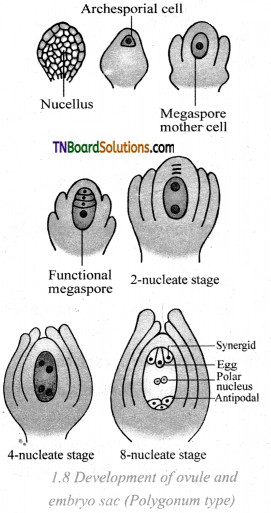
Question 4.
Enumerate the characteristic features of anemophilous plants.
Answer:
- Pendulous, catkin-like flower or spike inflorescence are present.
- The flowers are brought well above the leaves with an elongated axis of the inflorescence.
- The perianth is absent or highly reduced.
- The stamens are numerous with long filaments, exerted and versatile anther.
- Enormous quantities of pollen grains are produced compared to the number of ovules available for pollination.
- The pollen grains are minute, light, and dry in order to transport long-distance by the wind.
- In some plants like Urtica, the anthers burst violently and release the pollen into the air.
- Stigmas are comparatively large protruding, sometimes branched feathery, and adapted to catch the pollen grains.
- Generally, a single ovule is present.
- Flowers are produced before the new leaves appear so that the pollen can be carried by wind without any hindrance of leaves.
![]()
Question 5.
Explain the term Apomixis. Add a note on its types.
Answer:
Apomixis is the phenomenon in which reproduction does not involve the union of male and female gamete. Whereas the fertilization involving the union of male and female gametes in flowering plants is called amphimixis. Winkler in 1908 introduced the term apomixis. This is the substitution of usual sexual reproduction and this does not involve meiosis and syngamy.
Apomixis was classified into two types as Recurrent and Non-recurrent by Maheswari in 1950.
Recurrent apomixis: This induces vegetative reproduction and agamospermy. Vegetative reproduction is the propagation of plants by any part other than seeds.
Eg: Bulbs – Allium
Bulbils – Fritilaria imparialis
Runner – Mentha arvensis
Sucker – Chrysanthemum
Agamospermy refers to the processes by which embryos are formed by eliminating meiosis and syngamy.
Non-recurrent apomixis: Haploid embryo sac developed after meiosis, develops into an embryo without fertilization.
Choose the correct answers:
1. Match the following:
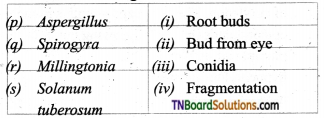
(a) (p)-(iv); (q)-(iii); (r)-(ii); (s)-(i)
(b) (p)-(iii); (q)-(iv); (r)-(i); (s)-(ii)
(c) (p)-(ii); (q)-(i); (r)-(iv); (s)-(iii)
(d) (p)-(iii); (q)-(i); (r)-(iv); (s)-(ii)
Answer:
(b) (p)-(iii); (q)-(iv); (r)-(i); (s)-(ii)
2. Match the following:

(a) (p)-(iv); (q)-(iii); (r)-(ii); (s)-(i)
(b) (p)-(iii); (q)-(iv); (r)-(i); (s)-(ii)
(c) (p)-(iii); (q)-(iv); (r)-(ii); (s)-(i)
(d) (p)-(ii); (q)-(i); (r)-(iv); (s)-(iii)
Answer:
(c) (p)-(iii); (q)-(iv); (r)-(ii); (s)-(i)
![]()
3. Match the following:
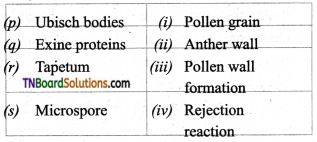
(a) (p)-(iv); (q)-(iii); (r)-(ii); (s)-(i)
(b) (p)-(iii); (q)-(i); (r)-(iv); (s)-(ii)
(c) (p)-(ii); (q)-(i); (r)-(iv); (s)-(iii)
(d) (p)-(iii); (q)-(iv); (r)-(ii); (s)-(i)
Answer:
(d) (p)-(iii); (q)-(iv); (r)-(ii); (s)-(i)
4. Match the following:


(a) (p)-(iii); (q)-(i); (r)-(iv); (s)-(ii)
(b) (p)-(iv); (q)-(ii); (r)-(iii); (s)-(i)
(c) (p)-(ii); (q)-(i); (r)-(iv); (s)-(iii)
(d) (p)-(ii); (q)-(iii); (r)-(iv); (s)-(i)
Answer:
(a) (p)-(iii); (q)-(i); (r)-(iv); (s)-(ii)
5. Match the following:

(a) (p)-(iv); (q)-(iii); (r)-(i); (s)-(ii)
(b) (p)-(iv); (q)-(iii); (r)-(ii); (s)-(i)
(c) (p)-(iv); (q)-(i); (r)-(ii); (s)-(iii)
(d) (p)-(ii); (q)-(i); (r)-(iv); (s)-(iii)
Answer:
(b) (p)-(iv); (q)-(iii); (r)-(ii); (s)-(i)
6. Who discovered the process of syngamy?
(a) E. Strasburger
(b) G.B. Amici
(c) Hofmeister
(d) E. Hanning
Answer:
(a) E. Strasburger
![]()
7. Vegetative propagation takes place through leaf buds in:
(a) Hibiscus
(b) Begonia
(c) Mango
(d) Malus
Answer:
(b) Begonia
8. The inner tangential wall of anther develops bands of:
(a) Polysaccharides
(b) Glycoprotein
(c) a cellulose
(d) p cellulose
Answer:
(c) a cellulose
9. Matured anther cavity is filled with:
(a) Megaspore
(b) Young microspore
(c) Embryo sac
(d) Pollen grain
Answer:
(d) Pollen grain
10. Epihydrophily type of pollination takes place in:
(a) Hydrilla
(b) Elodea
(c) Ipomea
(d) Pistia
Answer:
(b) Elodea
11. Choose the odd one out.
(a) Protogyny
(b) Cleistogamy
(c) Autogamy
(d) Homogamy
Answer:
(a) Protogyny
12. Find out the odd one:
(a) Cutting
(b) Grafting
(c) Micropropagation
(d) Air layering
Answer:
(c) Micropropagation
![]()
13. Choose the odd one.
(a) Endothecium
(b) Nucellus
(c) Tapetum
(d) Epidermis
Answer:
(b) Nucellus
14. Identify the odd one.
(a) Chalaza
(b) Endothelium
(c) Hilum
(d) Ubisch bodies
Answer:
(d) Ubisch bodies
15. Choose the odd one out.
(a) Orthotropous
(b) Microsporous
(c) Hemianatropous
(d) Campylotropous
Answer:
(b) Microsporous
16. Choose the incorrect pair.
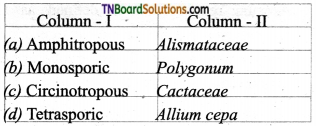
Answer:
(d)
17. Choose the correct pair.
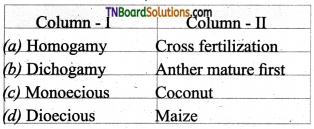
Answer:
(c)
![]()
18. Choose the incorrect pair.
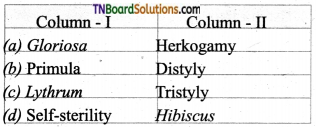
Answer:
(d)
19. Identify the correct pair.
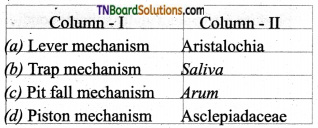
Answer:
(c)
20. Choose the incorrect pair.


Answer:
(d)
21. Assertion: The cells of endothecium are hygroscopic in nature.
Reason: They absorb water from air.
(a) Assertion is true and the Reason is false.
(b) Assertion is false and the Reason is true.
(c) Both Assertion and Reason are true.
(d) Both Assertion and Reason are false.
Answer:
(c) Both Assertion and Reason are true.
![]()
22. Assertion: P0llen grains are the immediate product of meiosis of the microspore mother cell.
Reason: the p0llen grains have a diploid number of chromosomes.
(a) Assertion is true and the Reason is false.
(b) Assertion is false and Reason is true.
(c) Both Assertion and Reason are true.
(d) Both Assertion and Reason are false.
Answer:
(d) Both Assertion and Reason are false.
23. Assertion: The filiform apparatus of synergids guides the pollen tube into the egg.
Reason: It helps in the absorption and conduction of nutrients.
(a) Assertion is true and the Reason is false.
(b) Assertion is false and the Reason is true.
(c) Both Assertion and Reason are true.
(d) Both Assertion and Reason are false.
Answer:
(a) Assertion is true and the Reason is false.
24. Assertion: self-p0llinati0n is possible only in those plants which bear bisexual flowers.
Reason: The availability of pollen and stigma are in the same flower for self-pollination.
(a) Assertion is true and the Reason is false.
(b) Assertion is false and the Reason is true.
(c) Both Assertion and Reason are true.
(d) Both Assertion and Reason are false.
Answer:
(c) Both Assertion and Reason are true.
25. Assertion: In some bisexual flowers, anthers and stigma mature at different times.
Reason:
This is a special adaptation in plants to prevent cross-fertilization.
(a) Assertion is true and the Reason is false.
(b) Assertion is false and the Reason is true.
(c) Both Assertion and Reason are true.
(d) Both Assertion and Reason are false.
Answer:
(d) Both Assertion and Reason are false.
![]()
26. Which of the following statement is correct?
(a) Budding is the method of asexual reproduction in spirogyra.
(b) Formation of conidia is the method of asexual reproduction in penicillium.
(c) asexual reproduction in planaria is the production of gametes.
(d) In hydra, the asexual reproduction is through the fragmentation method.
Answer:
(b) Formation of conidia is the method of asexual reproduction in penicillium.
27. Choose the incorrect statement.
(a) In mango, grafting is followed for vegetative propagation.
(b) In moringa, the stem cutting method is followed for vegetative propagation.
(c) In Hibiscus, leaf-cutting method is followed for vegetative propagation.
(d) In the Ixora plant, the layering method is followed by vegetative propagation.
Answer:
(c) In Hibiscus, leaf-cutting method is followed for vegetative propagation.
28. Find out the correct statement.
(a) Androecium and gynoecium are died essential organs for reproduction in plants.
(b) In protandrous flowers die gynoecium matures first.
(c) In protogynous flowers the androecium matures first.
(d) None of the above statements is correct.
Answer:
(a) Androecium and gynoecium are died essential organs for reproduction in plants.
29. Which of the following statement is false?
(a) The formation of haploid microspores from diploid microspore mother cell is through meiosis.
(b) The primary sporogenous cells may undergo a few meiotic divisions to form sporogenous tissue.
(c) The microspore mother cells are formed from the sporogenous tissue.
(d) All the above statements are correct.
Answer:
(b) The primary sporogenous cells may undergo a few meiotic divisions to form sporogenous tissue.
![]()
30. Choose the correct statement.
(a) Orthotropous type of ovule is present in Cactaceae.
(b) Anatropous type of ovules are found in dicots and monocots.
(c) Hemianatropous type of Ovule is present in Alismataceae.
(d) Amphitropous type of ovule is present in Cactaceae.
Answer:
(b) Anatropous type of ovules are found in dicots and monocots.